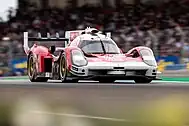Motorsport
Motorsport(s), or motor sport(s), are sporting events, competitions and activities that primarily involve the use of automobiles. Historically, the terms have encompassed sporting use of other motorised vehicles including motorcycles, motorboats and powered aircraft, however, specific terms are now more commonly used in these areas such as motorcycle sport, power boating and air sports.[1][2][3][4]
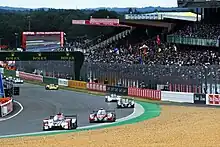
Different manifestations of motorsport with their own objectives and specific rulesets are known as disciplines; examples are circuit racing, rallying or trials. Governing bodies, also called sanctioning bodies, often have general rules for each discipline, allowing supplementary rules to define the character of competitions, series' or championships. Groups of these are often categorised informally, for example into vehicle type, surface type or propulsion method. Examples of categories within a discipline are formula racing, touring car racing, sports car racing etc.[5][6][7]
Governing bodies
The Fédération Internationale de l'Automobile (FIA), formed in 1904, is the oldest and most prominent international governing body. It claims to be the sole international motor sporting authority for automobiles and other land vehicles with four or more wheels, whilst acknowledging the authority of the Fédération Internationale de Motocyclisme (FIM) over vehicles with one to three wheels, which FIM calls motorcycle sport.[8][7]
FIM and FIA are both recognised as international sports federations by the International Olympic Committee.[9][10]
FIA hierarchy
Within the FIA's structure, each affiliated National Sporting Authority (ASN) is recognised as the sole authority in their nation. Permission of the ASNs must be obtained to organise motorsport, and their licenses must be held by participants. Not all ASNs function in the same manner, some are private companies such as Motorsport UK, some are supported by the state such as France's FFSA, or in the case of the US's ACCUS, a council of sanctioning bodies is the national representative at FIA meetings.
ASNs, their affiliated clubs or independent commercial promotors organise motorsport events which often include competitions. A collective of events is called a series, and a grouping of competitions often forms the basis of a championship, cup or trophy.
| International | National Sporting Authority[11] | ASN Members/Associates etc |
|---|---|---|
| FIA | BRDC (British GP), BARC (BTCC), BRSCC (British GT), …[12] | |
| Regional associations of motor clubs, motor/driver/racing clubs | ||
| ACO (24 Hours of Le Mans) … | ||
| IMSA, Indycar, NASCAR, NHRA, SCCA, USAC[13] |
Unaffiliated automobile sport bodies
Not all nations have a sporting authority affiliated with the FIA, some disciplines may not fall within the FIA's remit of control, or organisations may choose to ignore the claim of the authority of others. Examples include banger racing and stock car racing in the United Kingdom which are claimed by both the Oval Racing Council and the National Stock car Association,[14][15] despite the claim by the FIA affiliated ASN, Motorsport UK, to be the "governing body of all four-wheel motorsport in the UK".[16] SCORE International, National Auto Sport Association and National Off-Road Racing Association of the United States are also not members of the FIA affiliation system.
History
In 1894, the French newspaper Le Petit Journal organised a contest for horseless carriages featuring a run from Paris to Rouen. This is widely accepted as the world's first motorsport event.[17]
In 1900, the Gordon Bennett Cup was established. Closed circuit racing arose as open road racing, on public roads, was banned.
Motorsport was a demonstration event at the 1900 Summer Olympics.
Following World War I, European countries organised Grand Prix races over closed courses. In the United States, dirt track racing became popular.[18]
After World War II, the Grand Prix circuit became more formally organised. In the United States, stock car racing and drag racing became firmly established.[19]
Disciplines of automobile sport
Circuit racing
Circuit racing takes place on race tracks at permanent autodromes or on temporary street circuits. Competitors race over a set number of laps of the circuit, or for a set length of time, with the winner being the first to finish, or having completed the highest number of laps, with others classified subsequently.
Circuit racing replaced point-to-point (city-to-city) racing early in the history of motorsport, for both spectator appeal and as safety concerns brought in regulation of the sport, forcing organisers to use closed, marshalled and policed circuits on closed public roads. Aspendale Racecourse in Australia in 1906 was the first purpose-built motor racing track in the world.[20] After which, permanent autodromes popularly replaced circuits on public roads.
- Open-wheel racing involves vehicles with wheels that protrude from the chassis and body of the car. In general, open-wheel cars only carry the driver and are also known as single-seaters.
- Formula racing is an informal collection of series that use a specific set of rules for race car design. The most prevalent international series are Formula One and Formula Two. Others include Formula 3, Formula Ford, Formula Renault and Formula Palmer Audi. Former 'Formula' series include Formula 5000, GP2 and GP3.
- Formula One is an international championship governed by the FIA and currently promoted by the privately owned company, Formula One Group. The regulations contain a strict set of rules which govern vehicle power, weight, size and design. The rules do allow for some variation however.[21]
- Formula E is a championship of open-wheel racing that uses only electric-powered cars. The series was conceived in 2012 and the inaugural championship started in Beijing on 13 September 2014.[22] The series is also sanctioned by the FIA and races a spec chassis/battery combination, with manufacturers allowed to develop their own electric power-trains. The series has gained significant traction in recent years.[23]
- IndyCar Series originated on June 12, 1909, in Portland, Oregon.[24] Shortly after, Indianapolis Motor Speedway opened in 1909 and held races that ranged from 50 to 200 miles (80 to 322 km). Its premier race is the Indianapolis 500 which began on May 11, 1911. Today, IndyCar operates with over 20 teams and 40 different drivers.
- Enclosed-wheel racing involves vehicles with wheels primarily enclosed inside the bodywork of the vehicle.
- Sports car racing is a category that includes production based grand touring (GT) and sports cars, and specialised racing prototypes. The flagship race is the 24 Hours of Le Mans which takes place annually in France during the month of June. It is a constituent race of the FIA World Endurance Championship.
- Stock car racing originally used production 'stock' cars, the vehicles are now purpose-built race cars but maintain the body design and shape of production cars. The most prominent series are organised by NASCAR in the US, Canada and Brazil amongst other countries. Stock car racing series' in the UK and New Zealand use open-wheel single-seater race cars.
- Touring car racing involves modified passenger cars intended for road use.[25]
- Truck racing involves racing of modified large goods vehicle tractor units.
Off-road racing
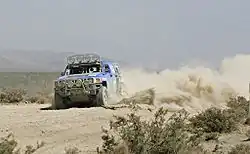
Off-road racing can take place on open terrain with no set path, or on circuits that do not have a sealed surface such as asphalt or concrete.
Notable off-road events on open terrain include the Baja 1000 desert race, organised by SCORE International.[26] The FIA authorise Extreme E, an electric off-road one-make series whose organisers have announced a hydrogen fuel series, Extreme H, to begin in 2025.[27]
Other off-road racing disciplines include:
- Rallycross
- Autocross (European)
- Lawn mower racing
- Autograss
Drag Racing
Drag racing is an acceleration contest, usually between two vehicles, along a short and straight course. Vehicles of various types can compete.
Karting
Kart racing uses very small and low vehicles known as go-karts. It is generally accepted as the most economical form of motorsport available on four wheels. As a free-time activity, it can be performed by almost anybody, and as a motorsport in itself, it is one of the sports regulated by FIA (under the name of CIK), permitting licensed racing for anyone from the age of 8 onward.
Rallying
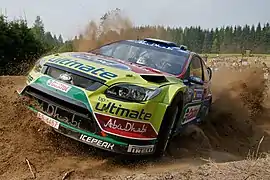
Rallying involves driving to a set itinerary, following a prescribed route and arriving and departing at control points at set times with penalties applied for diverging from the route or arriving late and early.
Special stages are used on some rallies where competitors drive against the clock. The classification of these rallies are determined by summing the times set with the fastest crews being victorious, as found in the World Rally Championship. This method is often called rally racing or stage rallying, whilst rallies that do not include special stages are distinctly regularity rallies.
Rallies that include routes that cover terrain off-road are also known as rally raid or cross-country rallies, the most famous example being the Dakar Rally. In the United States, the National Off-Road Racing Association (NORRA) was founded in 1967 along with the Baja 1000 race of that year that began in Tijuana and ended in La Paz. Since the 1990s, the race has been organised by SCORE International whilst NORRA's events have closer followed the FIA regulations and standards for cross country rallies, although the association has no affiliation to ACCUS, the US's FIA member.[28]
Other
Other disciplines of automobile sport include:
- autocross (auto slalom)
- hillclimbing
- demolition derby
- drifting
- gymkhana (motorkhana)
- monster truck events
- tractor pulling
- land speed record attempts
- trials
Other forms of motorsport
See also:
See also
References
- "Fédération Internationale de Motocyclisme | FIM". www.fim-moto.com. Retrieved 2023-09-26.
- "Motorcycle Sport & Bike Racing News | MotoGP, World Superbikes & More | MCN". www.motorcyclenews.com. Retrieved 2023-09-26.
- "Union internationale motonautique". www.uim.sport. Retrieved 2023-09-26.
- "The Federation | World Air Sports Federation". www.fai.org. 2017-06-28. Retrieved 2023-09-26.
- "Organising Events for Different Disciplines". Motorsport UK. Retrieved 2023-10-07.
- "Types of Motor Sport - Motorsport UK - The beating heart of UK motorsport". Motorsport UK. Retrieved 2023-10-07.
- STATUTES AND BY-LAWS, FINANCIAL REGULATIONS, SPORTING CODE, DISCIPLINARY AND ARBITRATION CODE (PDF). Fédération Internationale de Motocyclisme. 2023.
- "ARTICLE 1.1 INTERNATIONAL REGULATIONS OF MOTOR SPORT". 2023 FIA International Sporting Code (PDF). FIA. 2023.
- "International Motorcycling Federation - Recognised Federation".
- "International Automobile Federation".
- "Members". Federation Internationale de l'Automobile. Retrieved 2023-10-08.
- "Find Clubs". Motorsport UK. Retrieved 2023-10-08.
- ACCUS-FIA. "ACCUS-FIA". ACCUS-FIA. Retrieved 2023-10-08.
- "ORCi | History-of-the-orci". www.orci.co.uk. Retrieved 2023-10-07.
- association, the national stock car. "the national stock car association". the national stock car association. Retrieved 2023-10-07.
- "FAQ - Motorsport UK - The beating heart of UK motorsport". Motorsport UK. Retrieved 2023-10-07.
- Gifford, p. 7.
- Gifford, p. 10.
- Gifford, p. 11.
- Gifford, p. 9.
- Jonathan Noble; Mark Hughes. "Discovering What Makes Formula One, Formula One". Formula One Racing For Dummies. Archived from the original on 2010-04-24. Retrieved 2015-08-10.
- Telegraph Sport (13 September 2014). "Formula E opens with spectacular crash involving Nick Heidfeld and Nicolas Prost as Lucas di Grassi claims win". Daily Telegraph. Archived from the original on 2022-01-12. Retrieved 13 September 2014.
- Formula E (31 July 2017). "Agag: This has been our take-off season". Archived from the original on 3 July 2018. Retrieved 4 September 2017.
- Benthem, Haiko; Straver, Patrick. "OpenWheelWorld.Net >> Indy Car historie". www.openwheelworld.net. Archived from the original on 18 April 2018. Retrieved 18 April 2018.
- "Car Facts | Pirelli World Challenge". www.World-Challenge.com. Archived from the original on 2015-10-10. Retrieved 2015-10-09.
- "Off-Road Racer: The Grandfather of Off-Road Racing: BAJA 1000 - race-deZert.com". race-dezert.com. 21 December 2014. Archived from the original on 18 April 2018. Retrieved 18 April 2018.
- Baldwin, Alan (2023-09-07). "Extreme E plans switch to hydrogen as Extreme H from 2025". Reuters. Retrieved 2023-10-19.
- 2023 General Rules Version 4.0 (PDF). NORRA. 2023.
- Gifford, Clive (2006). Racing: The Ultimate Motorsports Encyclopedia. Kingfisher. ISBN 9780753460405.
.jpg.webp)
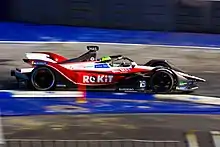
.jpg.webp)

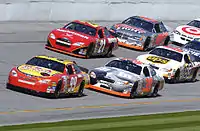
_FP1.jpg.webp)
